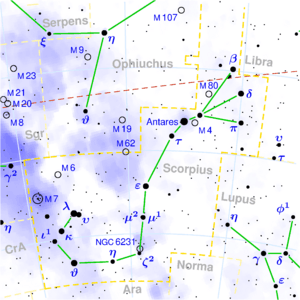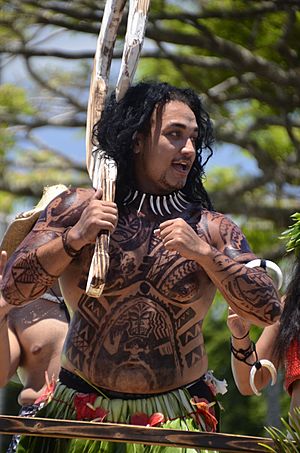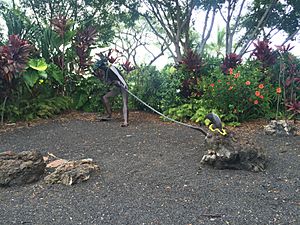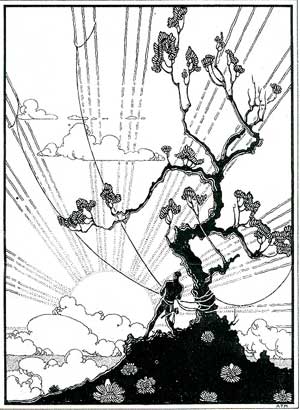Māui (Hawaiian mythology) facts for kids
In Hawaiian religion, Māui is a famous culture hero and an ancient chief. He appears in many old Hawaiian stories. In the Kumulipo, which is a long chant about creation, Māui is the son of ʻAkalana and his wife Hina-a-ke-ahi (Hina). They had four sons, and Māui-a-kalana was one of them. Māui-a-kalana's wife was Hinakealohaila, and their son was Nanamaoa. Māui is known as one of the Kupua, which means he had special powers. The Hawaiian island Maui shares his name, but it's said to be named after the son of Hawaii's discoverer, who was himself named after Māui.
Contents
Legendary Exploits
How Māui Fished Up the Hawaiian Islands

Māui had a giant fishhook called Manaiakalani. He used a special bait: a wing from Hina's pet bird, the ʻalae. People say Māui created the Hawaiian Islands by playing a trick on his brothers. He convinced them to go fishing with him. Once out at sea, his hook got stuck on the ocean floor. Māui told his brothers he had caught a huge fish and urged them to paddle as hard as they could.
His brothers paddled with all their strength, focusing so much on their effort that they didn't notice islands rising behind them! Māui repeated this trick several times, and that's how the Hawaiian Islands were formed.
Another story says that Māui was trying to fish up the god of fish, Pimoe. He told his brothers not to look back, or their mission would fail. But Hina, Māui's mother, appeared on the water's surface as a gourd. Māui accidentally picked up the gourd and placed it near him. Suddenly, it turned into a beautiful woman! The brothers couldn't resist looking at her. When they did, the fishing line broke, Hina disappeared, and the islands could not be joined into one big landmass.
Māui Slows Down the Sun
Māui's next big adventure was to make the sun move slower. His mother, Hina, complained that her kapa (bark cloth) couldn't dry because the days were too short. So, Māui decided to help.
He climbed to the top of the mountain Haleakalā, which means house of the sun. As the sun began to rise, Māui used a strong rope made from his sister's hair to lasso the sun's powerful rays. The sun begged for its life and agreed to Māui's terms: the days would be long in summer and short in winter. This is why we have different day lengths throughout the year!
In another version of this story, Hina sends Māui to a big wiliwili tree. There, he finds his old, blind grandmother setting out bananas. Māui cleverly steals the bananas one by one until she recognizes him. She then agrees to help him. He sits by the tree's trunk to rope the sun. The constellation Māui's fishhook (which we in the West call Scorpio) is named after this amazing feat.
Māui the Fisherman
Māui often went fishing with his brothers in the coral reefs below Haleakalā. Even though he had a magical hook that could catch anything, he didn't always use it for everyday fishing. Sometimes, his brothers would tease him because he didn't bring in many fish. But Māui always found a way to get back at them by playing clever tricks.
Māui Lifts the Sky
One day, Māui noticed that people were struggling because the sky was too low. They couldn't stand up straight! Māui felt terrible seeing the people of Earth suffer. He wanted to help them. So, Māui went to find his father to get help in lifting the sky.
Māui traveled to the town of Lahaina to meet his father. He lay down, bracing himself, and used his great strength to push the sky up. Then, Māui gave a signal to his father to start pushing too. With the combined power of father and son, they were able to push the sky high enough. This allowed people on Earth to stand upright and do their daily tasks comfortably. Some stories say that if Māui and his father, Ru, hadn't worked together, the sky might have fallen completely, making Earth impossible for humans to live on. They truly saved mankind!
Māui Defeats the Long Eel
After Māui had fished up the islands, he wondered what was on them. He traveled to different islands and found that they were all good places to live. There were kapa houses, but no one lived in them. The Ahupua'a (land divisions) were completely empty.
Māui learned many new things while visiting these islands. He decided to go home and live in a way that respected the new houses he had seen. Māui then found Hina and made her his wife. She lived in a well-kept thatched house.
One day, Hina went to the river bank to get water for herself and Māui. There, she met a long eel named Tuna. Tuna attacked her and covered her with slimy mud. Hina managed to escape back to the house but didn't tell Māui what had happened. The next day, it happened again, and this time Hina told Māui. Māui then went to the river banks to find and kill Tuna.
Māui was very angry and planned to punish the long eel. He set traps to make the eel come out of hiding. When Tuna appeared, Māui pulled out his stone axe and killed the eel. The Long Eel had been causing trouble for many people in the towns, but thanks to Māui, everyone was safe. Māui then buried Tuna, and from that spot, a palm tree grew, creating the very first coconuts.
In Popular Culture

In the 2016 Disney movie Moana, the demigod Maui is voiced by Dwayne Johnson. In the film, Maui was abandoned by his human parents as a baby. The gods felt sorry for him and made him a demigod, giving him a magic fish hook that allowed him to change his shape. He performed many amazing deeds to earn humanity's love, and each deed gave him a new animated tattoo. He is famous for stealing the heart of Te Fiti, a powerful island goddess who creates life. Moana, the main character of the movie, convinces him to help her return it. In his song "You're Welcome," written by Lin-Manuel Miranda, Maui mentions and takes credit for many of the heroic acts he is known for in old stories. This version of Maui combines parts of the Māui from Māori mythology and other Polynesian narratives.
Maui was also featured in Israel Kamakawiwo'ole's song "Maui Hawaiian Sup'pa Man." This song is on his most famous album, Facing Future, which is the best-selling Hawaiian album of all time.



